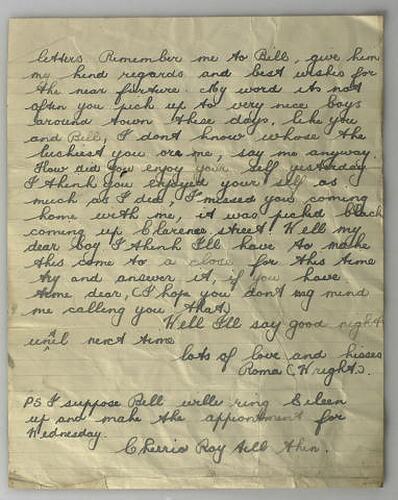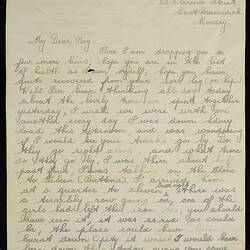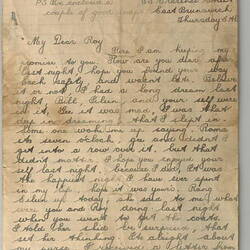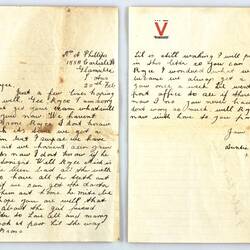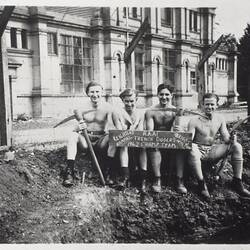Summary
Final page of letter from Roma Wright to 'Roy' (probably Royce Phillips). Asks to be remembered to Bill. Mentions it is not often that one can pick up two such nice boys around town. She thinks he enjoyed himself as much as she did. She supposes Bill will ring Eileen to make an appointment for Wednesday. Undated; probably late 1941 to early 1942, as Royce only enlisted in the RAAF in December 1941.
The letter was found under the floorboards of the balcony level of the Gallery, Great Hall, Royal Exhibition Building, when replaced in 1989 as part of a restoration program. Many other items dating back to the 1940s were also found, providing an insight into the lifestyle and interests of RAAF personnel stationed in the building.
The addressee may be Royce Phillips, who served as a Leading Aircraftman (AC1, or Aircraftman) in the Royal Australian Air Force during World War II, service number 47290. He enlisted on 9 December 1941 at Kilkenny, SA, and was discharged 5 Mar 1946. The suggestion of addressee is supported by a later letter clearly addressed to him that asks 'what has happened to Roma?' in response to a letter from Royce about a new girlfriend (SH 960274).
The formal wartime occupation of the Exhibition Building began in October 1940, when it was requisitioned for the RAAF under the National Security (General) Regulations. Partitioning work began in January 1941, and on 15 March the RAAF no.1 School of Technical Training was moved to the Exhibition Building from West Melbourne Technical School. Before long the Great Hall and surrounding areas were crowded with Air Force personnel. About 500 to 700 men lived there for varying periods of time; numbers peaked in 1942, when about 2000 personnel were accommodated. The central part of the building was a mess hall. The arena was occupied by a kitchen, laundry blocks, a storeroom and a playing field. The southern and eastern sides of the building were used for parades and drilling. The RAAF remained in control of the Exhibition Building until October 1946. (David Dunstan,1996, Victorian Icon)
Physical Description
Final page of letter, written on lined paper.
Significance
This letter is significant as a rare and unintended survivor of a war-time romance in Melbourne. Its sender is identified as Roma Wright. A Roma Wright is named in the Argus on 25 July 1946, page 8 - one of a group of debutants, all hairdressers, at the cabaret ball of the Master Ladies Hairdressers' Association in the St Kilda Town Hall. On 30 June 1947, p.7, the Argus reports that Roma Wright of St Kilda has married Harold Anderson and has sailed to the United States - so presumably Harold was American. It is not known if this is the same Roma Wright who wrote the letter ST 960281.
More Information
-
Collection Names
-
Collecting Areas
-
Acquisition Information
Transfer from Trustees of the Royal Exhibition Building (REB), Sep 1991
-
Place & Date Written
-
Place & Date Used
Melbourne, Greater Melbourne, Victoria, Australia, 1940-1945
-
Addressed To
-
Inscriptions
Handwritten text in blue ink.
-
Classification
-
Category
-
Discipline
-
Type of item
-
Overall Dimensions
19.2 cm (Length), 24.5 cm (Height)
-
Exhibition Collection Management
193 mm (Width), 244 mm (Height)
-
Dimensions
245 mm (Length), 194 mm (Width)
Measurement From Conservation. Measuring Method: Maximum dimensions of pages
-
References
[Book] Dunstan, David. 1996. Victorian Icon: The Royal Exhibition Building., 377-386 Pages
-
Keywords
Correspondence, Royal Exhibition Building, Wars & Conflicts, World War II, 1939-1945
